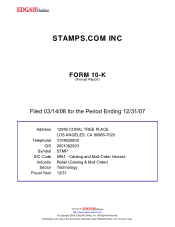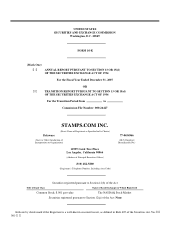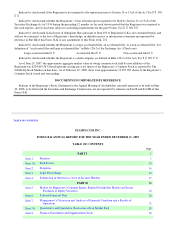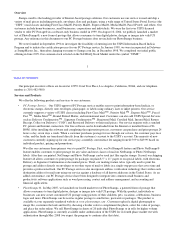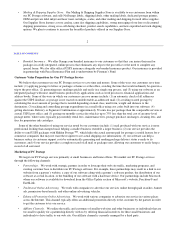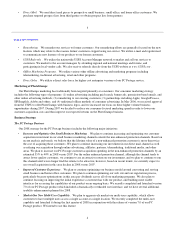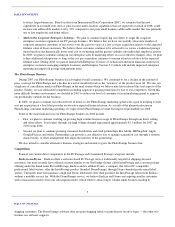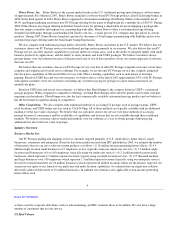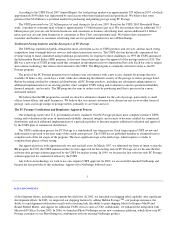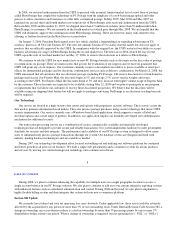Stamps.com 2007 Annual Report Download - page 10
Download and view the complete annual report
Please find page 10 of the 2007 Stamps.com annual report below. You can navigate through the pages in the report by either clicking on the pages listed below, or by using the keyword search tool below to find specific information within the annual report.
According to the USPS Fiscal 2007 Annual Report, the total postage market was approximately $75 billion in 2007, of which
approximately $54 billion was represented by mail classes other than standard mail and periodicals. We believe that some
portion of this $54 billion is a potential market for purchasing and printing postage using PC Postage.
The USPS processed over 212 billion pieces of mail during its fiscal year 2007. Based on the USPS 2005 Household Diary
study, consumer-to-consumer mail volume is approximately 5.9 billion pieces per year. We also estimate that an additional 10.5
billion pieces per year are sent between businesses and consumers as business advertising mail, and an additional 8.6 billion
pieces per year are sent from businesses to consumers as First Class correspondence mail. We believe that consumer-to-
consumer and business-to-consumer advertising mail are two potential markets for use of PhotoStamps.
Traditional Postage Industry and the Emergence of PC Postage
The USPS has experienced public demand for more convenient access to USPS products and services, and has faced strong
competition from overnight delivery services and online transaction services. The USPS also has historically experienced lost
revenue owing to fraud committed using traditional postal meters. In response to these challenges, in 1995 the USPS announced
the Information Based Indicia (IBI) program, its first new form of postage since the approval of the postage meter in 1920. The
IBI was a new type of USPS postage mark that contained an information rich two dimensional bar code. Each bar code is unique
and contains technology that reduces the fraud risk to the USPS. The IBI program is commonly referred to today as the PC
Postage program.
The goals of the PC Postage program were to enhance user convenience with a new access channel for postage that was
available 24 hours a day, seven days a week, while also enhancing the inherent security of the postage to reduce postage fraud.
Before becoming certified for commercial distribution, all PC Postage products, including any subsequent enhancements or
additional implementation of an existing product, must complete USPS testing and evaluation to ensure operational reliability,
financial integrity, and security. The IBI program also aims to reduce costs by producing mail that is processed in a more
automated fashion.
We believe that the IBI program has created an attractive alternative channel for the sale of postage, particularly to small
offices, home offices and small businesses. We believe that our current customers have chosen our service over other forms of
postage, such as postage stamps or postage meters, primarily to save time and cost.
The PC Postage Certification and Regulatory Approval Process
Our technology meets strict U.S. government security standards. Our PC Postage products must complete extensive USPS
testing and evaluation in the areas of operational reliability, financial integrity and security to become certified for commercial
distribution, and each additional implementation of a particular product or function requires additional evaluation and approval
by the USPS prior to commercial distribution.
The USPS certification process for PC Postage is a standardized, ten-stage process. Each stage requires USPS review and
authorization to proceed to the next stage of the certification process. The USPS has no published timeline or estimated time to
complete each of the ten stages of the program. The most significant stage is the ninth stage, which requires a vendor to
complete three phases of beta testing.
Our approval process took approximately two and one half years. In March 1997, we submitted our letter of intent to join the
IBI program. In 1998, the USPS announced that we were approved for beta testing and our PC Postage service became the first
software-only postage solution approved by the USPS for market testing. In 1999, we became the first software-only PC Postage
solution approved for commercial release by the USPS.
Any follow-on technology we wish to use also requires USPS approval. In 2002, we successfully launched NetStamps and
became the first provider of this technology. Approval for NetStamps followed years
7
TABLE OF CONTENTS
of development efforts, including a six-month beta field test. In 2002, we launched our shipping label capability after significant
development efforts. In 2003, we improved our shipping features by adding Hidden Postage
TM
, our package insurance, the
ability to send shipment notification e-mails with a tracking link, the ability to print shipping labels for Express Mail® and
Bound Printed Matter, and support for additional USPS services such as COD. Additionally, we enhanced the integration with
Microsoft® Office System 2003. In 2006, we launched Photo NetStamps on our new ecommerce platform, which allows our PC
Postage customers to use PhotoStamps in combination with our existing NetStamps product.

